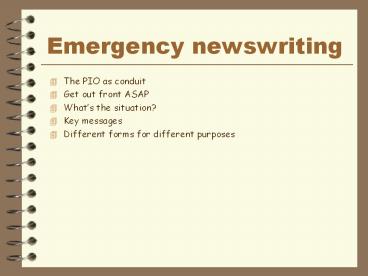Emergency newswriting - PowerPoint PPT Presentation
1 / 25
Title:
Emergency newswriting
Description:
Associated Press (AP) Stylebook. The media's language guide. Spelling, capitalization, punctuation, abbreviation and other usage ... – PowerPoint PPT presentation
Number of Views:66
Avg rating:3.0/5.0
Title: Emergency newswriting
1
Emergency newswriting
- The PIO as conduit
- Get out front ASAP
- Whats the situation?
- Key messages
- Different forms for different purposes
2
Purpose
- To inform
- To direct action
- To do both
- Side benefit Your
agencys visibility to, and credibility
with, the public
3
Shaping information
- Content
- Formatting
- Forms
- Resources
4
Resources
- Oak Ridge pocket guide
- Associated Press (AP) Stylebook
- The medias language guide
- Spelling, capitalization, punctuation,
abbreviation and other usage - Also Internet guidelines, media law,
proofreaders marks
5
Basic content
- Accurate
- Timely
- Detailed, concise and clear
- Quotes attributed by name
- and title
6
Content
- Lead tells who, what, when, where, why and how
(5Ws1H) - Crisis Response Message Triangle
- Write newspaper-style from your organizations
perspective
7
Content
- Simple, clear language
- Short sentences, one thought
- Dont end with participial phrase
- Active verbs
- Make antecedents plain
- Avoid abbreviations and acronyms
8
Content
- Be precise
- Destroyed vs. completely destroyed
- Escape vs. miraculous escape
- Frequently vs. always
- Died vs. passed away
- Critically injured vs. not expected to live
- Said vs. stated
- Dead on arrival vs. pronounced
- Left vs. exited
- History vs. past history
9
Shaping your content
- Use the Inverted Pyramid
Crucial Information
Lead Sentence
Prioritize succeeding
sentences
Less
Important
Write in declining
order of importance
10
Formatting the page
- Double-space--yes/no?
- Make margins wide as possible
- Margins used by editors to mark up
- Use one side of 8-1/2 x 11 paper
- Limit length
- Longer releases sometimes tossed and
your message is lost
11
Top of the page
- Letterhead
- Logo, name of organization, address
- Time of release
- FOR IMMEDIATE RELEASE
- RELEASE AT time/date
- Date (/time, if needed)
- Contact
- Name, title, phone number
Top of Page
12
Rest of the page
- Headline
- Subject of release, all caps
- Dateline (City, State)
- Body of copy
- Ending news releases
- centered at bottom
- Header for second page
Rest of Page
13
Forms of information
- News release
- First news release
- Fact sheet
- Backgrounder
- Talking points
- Internet
14
News release
- Most common written PIO tool
- Formally structured
- One to two pages
- AP style suited for media use
15
First news release
- A few sentences released ASAP
- First use of Crisis Response Message Triangle
- Indicates your agency is
- Responding quickly
- Managing incident effectively
- Establishes PIO contact for media
16
Fact sheet
- Bulleted sentences or phrases
- May include
- Straight facts, statistics
- Incident chronology
- What to do before, during, after
- Formal statements
- Other information
- Quick reference to incident information
- Good when demand for info high
17
Backgrounder
- Detailed narrative about a program, hazard, your
agency, etc. - Backgrounder about your agency
- Structure
- Leadership
- Preparedness and capabilities
- Historical, statistical, chronological
- Good for new reporters and reporters doing
in-depth stories
18
Talking points
- Use bullet points
- Use sentences/phrases of fact
- Use as notes to impart critical information
- Most effective in news conferences
19
Writing for the Internet
- Readers
- Writing for readers
- The basics of strong Web writing
20
How people read the Web
- Readers look at text first
- Readers focus on headlines, news briefs and
captions - Readers gloss over pictures, especially graphics
- Most readers look for something specific
- Source The Pointers Institutes Eye Track Study,
2000
21
Writing for Web readers
- Write straightforward, efficient headlines
- Use bullets
- Bold and highlight key facts
- Solid, concise writing is essential
- Use high-impact photos, tightly cropped
- Use interactive graphics that require reader
participation
22
Strong Web writing
- Use the inverted pyramid
- Use bullets and lists that can be easily scanned
- One idea per paragraph
- Half the word count of printed information
23
Strong Web writing, contd
- Use hypertext to organize material
- Use sources and citations for research, and
quoted material to enhance credibility - Use humor with caution
- Avoid promotional, marketese-type language
24
Follow up
- Check to see your message has reached the
intended audience - Monitor the media for
- accuracy
- correct context
25
Assignment
- Web posting and news release
- Decide who you are
- Time of release noted on scenario or fact sheet
- Handwritten or computed
- Due tomorrow morning
- Questions































